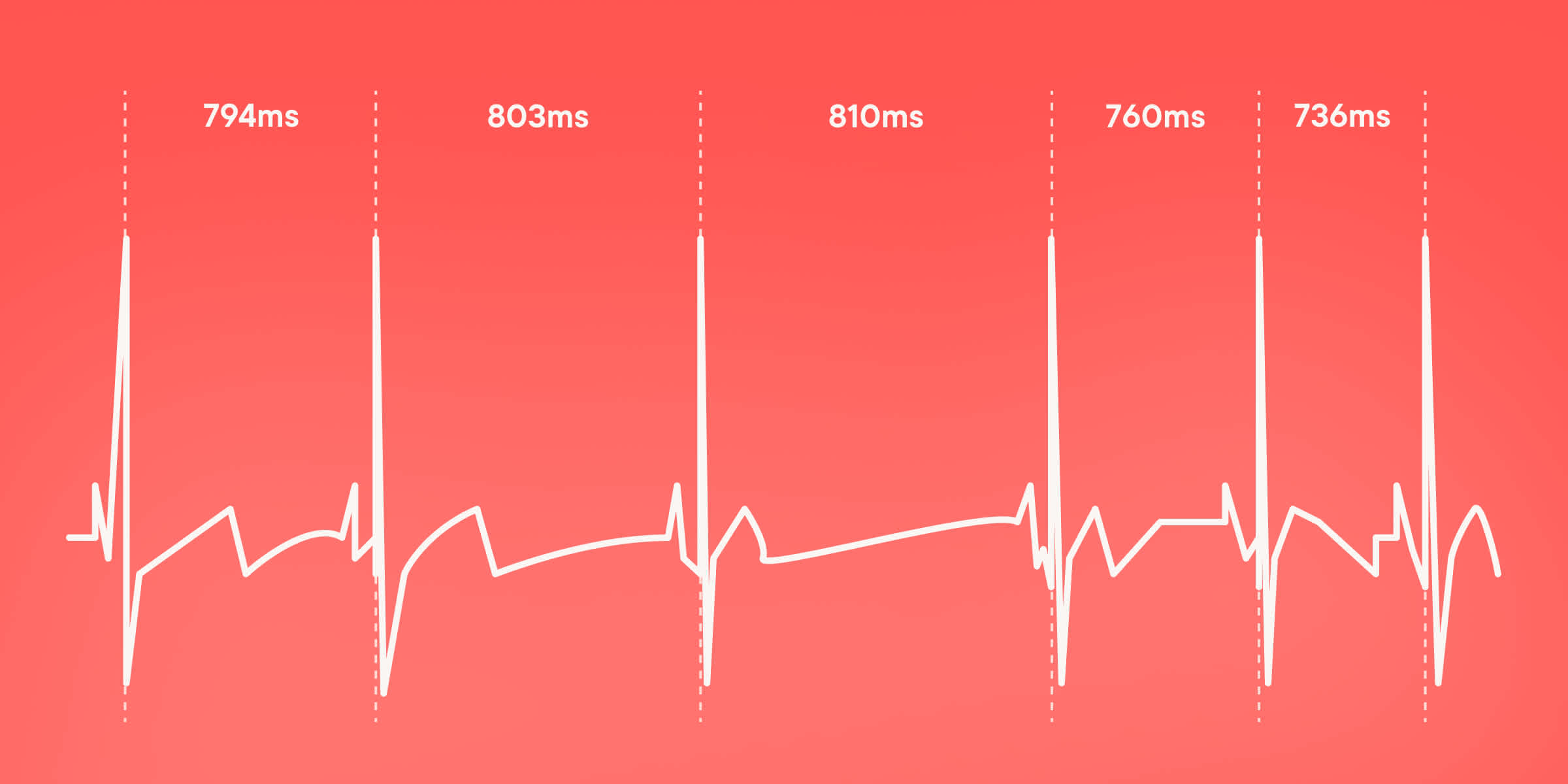Photography via Pexels
What your heart can tell you about your menstrual cycle
How resting heart rate and heart rate variability change with your cycle—and what those changes can reveal

Your heart holds more information than just how fast it beats. Resting heart rate (RHR) and heart rate variability (HRV) are two physiological signals (also known as biometrics) that offer insights into your stress, recovery, fitness, and hormonal health.
As wearables become part of everyday life, tracking these metrics is easier than ever. But what do they actually mean—and what can they tell you about your menstrual cycle?
What is resting heart rate (RHR)?
Resting heart rate is how many times your heart beats per minute when you’re completely at rest (1). It’s usually measured overnight or first thing in the morning. Most adults have a resting heart rate between 60–100 beats per minute (bpm), but athletes and very fit people may have a lower rate (1).
Your RHR can change daily. It tends to go up with stress, illness, dehydration, or poor sleep (2-4). A higher RHR might mean your body is working harder than usual (e.g., you’re stressed or getting sick).
A consistently lower RHR is often a sign of good cardiovascular health and recovery, especially in athletes or very active people (1). But for people who are not highly active, an unusually low resting heart rate (typically below 60 bpm) may indicate bradycardia, a condition that can cause fatigue, dizziness, or fainting (5).
If you notice these symptoms or are unsure whether your RHR is healthy for you, it’s a good idea to check with a healthcare provider.
What is heart rate variability (HRV)?
Heart rate variability is the variation in time between each heartbeat (6). Measured in milliseconds, it reflects how balanced your autonomic nervous system is. Think of it as a tug-of-war between your stress system (sympathetic) and your rest-and-recovery system (parasympathetic) (6,7).
A higher HRV usually means your body is recovering well and adapting to its environment. A lower HRV can mean you’re under physical, emotional, or hormonal strain (2,8). Most people will have an HRV in the range of 20–100 milliseconds, but it can sometimes be higher or lower (9). The exact value depends on how your device measures it. Some use different methods that produce higher or different values. So instead of focusing on a single number, it’s more helpful to track your own trends over time.
HRV also tends to decline with age, likely due to changes in nervous system responsiveness and cardiovascular function (9). For these reasons, your personal baseline and how it changes over time are more meaningful than comparing your number to anyone else’s.

How do you measure RHR and HRV?
HRV and RHR can be measured using an electrocardiogram (ECG) or a photoplethysmogram (PPG). Most people measure these biometrics using wearable devices like smart rings, smartwatches, or fitness trackers (10).
These devices often use nighttime data (while you’re asleep) to calculate daily averages, since the body is at rest and external factors are reduced (10). Some apps can measure HRV and RHR using your smartphone’s camera, a sensor, or a chest strap. You can measure your RHR by taking your pulse, but wearables tend to give more consistent data.
Keep in mind: RHR and HRV values are typically lower during sleep than when you’re awake. That’s why it’s important to compare like with like. Stick with the same measurement method and time of day when tracking trends, whether it’s a manual morning check-in or your wearable’s nightly average.
How do RHR and HRV relate to the menstrual cycle?
Some research has found that hormones influence RHR and HRV in cyclical ways:
In the follicular phase (the first half of your cycle), estrogen gradually rises. Some studies suggest that this phase may support greater parasympathetic activity, leading to a lower RHR and higher HRV (6,7,11,12). However, not all research agrees, and the pattern can vary from person to person (12).
Around ovulation, estrogen and luteinizing hormone peak. Some people see a slight rise in RHR and a dip in HRV at this point.
In the luteal phase (the second half of your cycle), progesterone becomes dominant. Some studies associate this phase with increased sympathetic nervous system activity, which may raise RHR and lower HRV (6,7,11,12).
With the start of menstruation, hormone levels drop, and both RHR and HRV may return to baseline (6,7,12).
These trends have been seen in both clinical research and wearable data. But not everyone will experience clear patterns, and more research is needed to fully understand individual variation.
What affects RHR and HRV?
These metrics may shift with your cycle, but many other factors also influence them, including:
Stress: Physical or emotional stress tends to raise RHR and lower HRV (2,6).
Exercise and recovery: Intense workouts can temporarily lower HRV and raise RHR, and rest helps both return to baseline (2,3).
Illness or infection: When your body is fighting something off, your RHR often rises and your HRV drops (2).
Alcohol and smoking: Both can affect your autonomic nervous system (2,14,15). If consumed regularly, these effects may shape your baseline readings over time.
Hydration and nutrition: Dehydration or under-fueling can impact blood volume and electrolyte balance, which can directly affect cardiovascular function (2-4,8,16).
Medications or hormonal treatments: Birth control, stimulants, antidepressants, and beta-blockers may influence these metrics (17-20).
Age, fitness, and genetics: Everyone’s baseline is different. HRV tends to decline gradually with age (9). People who are physically fit often have lower RHR and higher HRV due to better cardiovascular conditioning and nervous system flexibility (6,17). Genetics also play a role in setting your natural range (21). That’s why tracking your own patterns over time gives more meaningful insights than comparing your numbers to someone else’s.
What about menstrual health conditions and fertility?
Some research shows that HRV may be linked to certain menstrual health conditions. For example, people with premenstrual syndrome (PMS) may show bigger changes in HRV between phases of the cycle, while those with premenstrual dysphoric disorder (PMDD) tend to have lower HRV overall (17).
People with polycystic ovary syndrome (PCOS) often have lower average HRV, which may reflect hormonal or metabolic differences (22,23). In some people with fertility challenges, the expected shift in nervous system activity during the luteal phase (second half of the cycle) appears to be missing or reduced (17).
One study also found that people going through perimenopause who had lower HRV experienced more intense physical and emotional symptoms, suggesting that changes in nervous system function may affect how symptoms feel during this life stage (24).
Although researchers have studied HRV differences between people with and without these conditions, we still don't know how exactly HRV changes across the cycle in each group. More research is needed to understand whether HRV could help identify or monitor these conditions.
Tracking HRV over time might help surface individual patterns or point to disruptions worth discussing with a healthcare provider, but for now, it should be seen as one piece of a larger health picture.
What if I don’t see a cycle pattern?
Not everyone will see clear changes in RHR or HRV across their cycle—and that’s okay. Research has shown that cycle-related patterns do exist for some people, but other studies have found little or no consistent changes. The strength and visibility of these patterns likely vary based on individual physiology, measurement method, and timing. It might simply mean that your data hasn’t captured a full cycle yet, or that your body’s hormonal rhythms look different. It doesn’t necessarily mean something is wrong.
Here are a few reasons why cycle-related changes might be harder to detect:
You’re using hormonal birth control, which can flatten hormonal fluctuations (25).
You may not be ovulating (which can happen with PCOS or hypothalamic amenorrhea) (22,23,26)
You’re in a life stage with different hormonal rhythms, like pregnancy or post-menopause (13,27)
Your data is still stabilizing—try tracking across a few full cycles to see if patterns emerge
And keep in mind: HRV and RHR are also influenced by factors such as stress, sleep, travel, illness, and changes in your daily routine (2-4,6,14,15). So even if your metrics don’t follow a cycle pattern, they can still offer helpful insight into your overall health.
Why track these biometrics?
RHR and HRV give you an objective window into how your body is doing. Tracking them can help you:
Spot hormonal shifts and cycle phases (if present)
Understand your stress and recovery patterns
Notice early signs of illness or burnout
See how your lifestyle affects your cycle
Build a more complete picture of your menstrual and overall health
Resting heart rate and heart rate variability are two biometrics that reflect your body’s state. By syncing them with your menstrual tracking, you can learn how your cycle affects your whole system and tune in more deeply with your health, recovery, and hormonal patterns.
